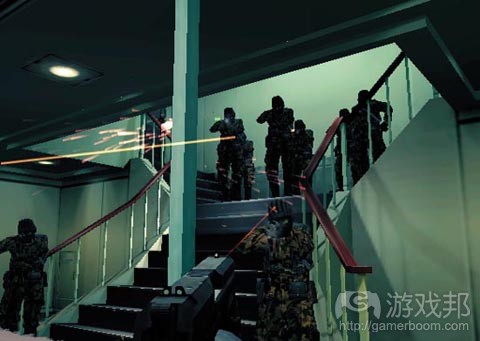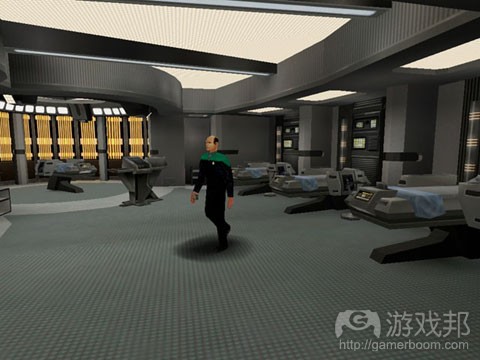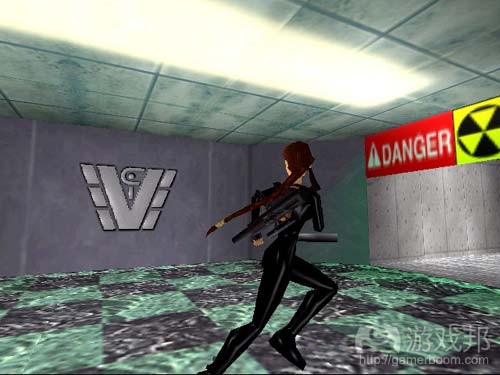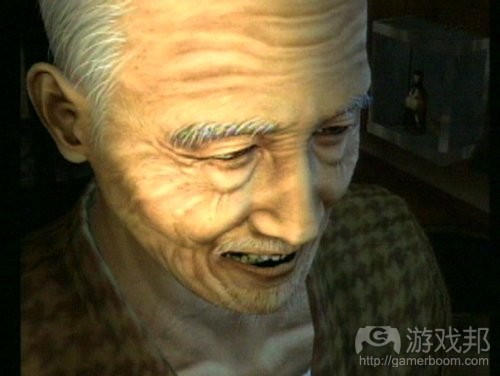阐述将小说典型特征用于游戏开发的建议
作者:Pascal Luban, Joël Meziane
电影游戏的需求急剧增加使其正在形成一股巨大的商机。为了进一步发展,游戏产业便需要不断扩展用户群体,并拉拢一些新玩家,如通常不会接触到当前电子游戏内容的休闲玩家和妇女们。并利用玩家所熟悉的元素(即电影和文学)去吸引他们的注意。
许多人都认为游戏永远不可能像电影或小说那样阐述故事,因为互动性将会大大限制编辑对于故事的控制。而我们将通过本篇文章去阐述如何创造出一款带给玩家类似电影般体验的游戏。
创造电影般的体验
小说的典型特征包括了主题,角色,脚本和作品。不管是小说,戏剧还是电影都具有这些特征。而作品的理念则最接近于电影和戏剧世界,但同样也适用于书籍中。作家总是会使用像选词,短语样式,叙述结构等技巧去呈现一个故事。不仅如此,导演和编辑家也可以使用这些技巧去吸引玩家沉浸于他们的电子游戏中。
游戏该如何重现优秀小说中所具有的氛围,紧张感与快节奏呢?它会缺失哪一环节?可以说这是伴随着适当游戏设计的一件作品。
游戏开发者也可以借鉴电影导演所拥有的技能去完善游戏的镜头选择,编辑以整体游戏宇宙所呈现出的感觉。许多游戏设计元素都允许开发者能够融合游戏玩法与类似于电影的相关内容。最后,游戏设计师还需要去理解小说的典型特征以及如何将其应用于游戏创造中。
利用玩家所熟悉的元素(即电影和文学)去吸引他们的注意。
镜头的选择
镜头可以说是任何视觉性作品的核心元素。镜头的选择能够帮助开发者有效地呈现出故事中的重要内容。广角镜头能够为玩家呈现出更广阔的环境——或者能够创造出一种孤立感。而特写镜头则能够强化观看者与角色间的联系,进一步突出角色的情感。同时特写镜头也能够创造出一种焦虑感,因为观看者将看不到镜头之外的其它环境。有些镜头还具有某些专业功能,如变焦或移动镜头去表现各种行动。
并不是所有镜头都适合游戏玩法。开发者所面临的挑战便是想办法让玩家适应电影般的视觉角度。以下我将列出三种缓解方法:
1.当“导演”所提出的电影般的镜头并不适合游戏玩法时,玩家便会暂时失去对角色的控制。举个例子来说吧,如果游戏镜头对于装饰品的呈现阻碍了玩家的游戏进程,那么游戏软件便会接过控制权而自动推着玩家向前进。尽管玩家暂时被剥夺了控制权,但却能够感受到最佳游戏视觉角度。
2.比起引导玩家前进,游戏玩法中包含了能够让玩家自己执行的命令。“如何成功”技巧只要求玩家能够做出正确的战术决策。《莎木》(游戏邦注:日本著名电玩游戏制作公司世嘉为旗下主机Dreamcast所制作的一个电玩游戏系列)便成功实践了这一方法。这款游戏之所以能够成功使用之前游戏中从未出现过的电影技巧是因为实际控制游戏角色并不存在任何问题。
3.不再优先考虑角色的敏捷性,而是让游戏利用一些看起来并不适合游戏玩法的镜头角度。《寂静岭》便使用了这种技巧。游戏开始于一条小路上,玩家唯一需要做的便是控制着角色往前进。而游戏镜头将沿着小路移动,让玩家能够更真切地融入游戏环境中。
编辑
编辑是导演技能中最难理解的一点。但是编辑也是赋予电影个性的最重要元素。
开发者可以在保留最真实的游戏玩法前提下利用多种编辑技巧去创造游戏。
1.在游戏过程中频繁使用过场动画。我们可以将这种短场景穿插于电影或游戏中;它们可以用于介绍角色,呈现出一个重要的目标或行动等。这种标志性时刻往往能够创造出一个新的转折,或提供给观众一些新的信息。优秀的编辑总是能够有序地排列各种事件去吸引观众的注意。在游戏中,过场动画能够有效地融入节奏较快的游戏关卡中。而开发者需要掌握的诀窍便是设计出与脚本保持平行的过场动画序列和游戏玩法。
2.通过改变摄像机镜头去呈现出视觉多样性,并以此吸引玩家的注意。取景能够有效地突出地点,角色,目标或事件。不同镜头的使用可以有效地平衡游戏玩法与电影般场景的使用。
3.使用快捷方式去避免冗长的行动将会打破游戏节奏,但却不会对游戏玩法造成任何影响。这种快捷方法可能是脚本中所规定的内容也有可能是由玩家自己所做出的决定。《合金装备》便证明了这种方法的有效性,即让角色能够通过滑进板条箱而跳到任何距离的位置上。
4.与环境相连接的音乐主题或特殊音效。的确,编辑不只需要包含图像,同样也不可遗漏掉音效。我们永远都不能低估声音的描述能力。声音设计是电子游戏设计中一大组成部分,它有可能在未来几年里迎来巨大的发展。
(《合金设备》使用快捷方式去避免冗长的行动而打破了游戏节奏,但却不会对游戏玩法造成任何影响。)
可信的宇宙
开发者必须创造一个可信的环境。你是否愿意看到玩家沉浸于一个角色和道具都“不合理”的故事中?如果设计师想要创造出一个可信的宇宙,他便需要重视以下内容:
1.角色动画必须与环境保持一致。即使角色只是简单地面对着一堵墙也不能毫无意义。当游戏中出现了一个障碍,角色就必须清楚自己应该越过它或绕过它——就像在《塞尔达传说:时之笛》那样。玩家能够控制角色,但同时角色也必须具有一定的智能能够适应不同环境而进行移动。在《合金装备2》中,遭遇追赶的蛇便会为了更快速地前进而跳下台阶。
(就像在《塞尔达传说:时之笛》中,角色必须理解该越过去或绕过去。)
2.创造出可信且详细的装饰品。从视觉上来看,可信的装饰品必须包含所有细节,从而让玩家感受到其“真实性”。在《鬼屋魔影4:新的梦魇》中我们便遇到了所有玩家希望看到的对象和装饰元素:温室边上的园艺工具,房屋里的衣服等等。如果我们希望装饰品能够更加可信,我们便可以尝试着将其放置于现实的地点中。
3.一致性不符合自然规律。创造出可信的宇宙的另一种方法便是避免重复性与一致性。放眼窗外,你会发现每一栋建筑都具有不同的风格。因为他们都不是出现于同一时间。大街上的每个人也都各不相同——他们穿着不同的衣服,具有不同的体形与身高,并且他们的行走节奏也均不同。这便是现实生活。
4.首先考虑“声音”。在看到一个地点前我们总是先通过声音去察觉到它的存在。在游戏中,声音总是引子一般的存在,同时它也能为环境呈现出别样的风味。例如,当角色沿着小路前进时,玩家不会反复听到相同的声音,因为这是声音所具有的随机属性,能够有效地传达出一个生动的宇宙。
5.充满各种古怪内容的背景。没有什么比看到房间或建筑物里放置着自己从未看过的细节内容更有个性的设置了。它可能只是一个装有雪茄烟头的烟灰缸,你希望在某种类型的房间中看到的装备,或者从收音机里飘出的音乐等。
6.运动中的宇宙。让一个简单的物品动起来便能够为其添加一个富有意义的背景故事。如《鬼屋魔影4:新的梦魇》中拂动的窗帘或《毁灭巫师》中被风吹拂着的落叶。大街上驰骋而过的汽车,仓库中缓慢旋转着的风扇以及远处扑腾着翅膀翱翔的鸟群等,都在勾勒着一个活灵活现的宇宙。
7.恶棍或电脑控制的角色的行为都必须具有真实性。比起完全依赖于完美的AI,游戏脚本还必须呈现出有关这些角色的适当介绍和行为规则。《Soldier of Fortune》中的敌人便能够自由移动,寻找避难场所并参加各种战斗。《合金装备》中的守卫更是呈现出了一种特别的存在:他们的一切行为都极端逼真,例如伸手,停下脚步环顾四周等。《神偷:暗黑计划》的守卫还能够进行对话,并在发现可疑行动时改变音量。所有的这些行为细节都将推动着玩家去相信自己在游戏过程中遇到的各种角色。如此设置能够让敌人显得更加可怕,同盟显得更加友善。
8.尽可能避免主观想法。主观想法可能会破坏游戏的电影维度,但是在某些游戏过程中却必须用到这种技巧。步枪瞄准镜或电视监视器便能够有效地将这一技巧整合进电影类电子游戏中。从这一点来看,玩家在《Hitman》中对于狙击兵的控制便具有真实性:交叉行动与角色的呼吸保持着一致,当玩家攻击一个目标时我们更是能够清楚地看到子弹所带来的冲击性。
9.确保角色所发动的攻击具有可信度。如此便能够让敌人显得更加脆弱而不是让我们的英雄去承受各种撞击。
适当的游戏设计
关于游戏设计有一个基本要求:我必须在此腾出一些空间去阐述这些原则。
游戏产业中长久流传着一种信念,即游戏的寿命至关重要。实际上,大多数玩家都不会坚持玩到游戏最后。关于这一点具有多种原因。首先,明确的游戏风格很容易让玩家感到厌烦。除此之外,当玩家精通了一款特殊游戏后,游戏的挑战性和乐趣也就不复存在了。许多玩家都会在遇到一个难以克服的难题或点时选择离开游戏。
因此游戏作者应该创造出不超过15个小时的游戏玩法,并更加注重游戏质量。当玩家完成游戏后便不会对其有更多的渴求,但是至少他们还是会期待着游戏续集的出现。尽管如此,开发者也仍可以使用相同的资源(游戏邦注:如装饰物,角色等)去延伸游戏寿命,所以这里也存在多种方法去确保游戏的重玩价值。
以下机制便是稳定游戏设计的基本构成元素:
线性游戏结构虽然能够引导着玩家前进,但同时也会留给他们自由行动的空间。在行动类游戏中这种结构越来越普遍。像《荣誉勋章》,《不死之灵》以及《合金装备》便都是基于这种模式。玩家并不需要在游戏中探索路径,相反的他将决定如何应对不断涌现出来的困难。如此设计师便能够有效地将事件整合到脚本中,并更容易控制游戏冒险的节奏。
行动与故事的完美融合。故事和脚本是围绕着冒险的发展进行设定。这一框架将提供个性序列事件,并保持整体节奏,进而吸引读者的注意。这便是行动所具有的意义。如果一款电子游戏想要具有真正的电影维度,那么开发者就需要避免将故事内容硬塞到两个行动场景间;而是应该将故事内容完全融入场景中。所以我们必须重新思考传统的关卡游戏所具有的结构。开发者必须适当且持续地将更多事件,新角色或信息投入于游戏中。《星际迷航:精英力量》便在冒险内容中插入了各种过场动画去实现这一目标。玩家是被叙述带进游戏故事中的,因此游戏必须有规律地向他们传达必要信息。切忌一下子向玩家呈现过多信息。游戏设计师总是很容易忘记玩家并未向他们那样了解游戏这一事实。如果设计师用大量信息将玩家掩埋,玩家便很容易迷失关注焦点。
一个丰富的故事是取决于突如其来的新变化而不是复杂性。避免使用过多情节而将故事复杂化。因为这只会导致陷入各种困惑而快速离开游戏。
重视次要角色。他们在故事中也发挥着重要的作用。他们将激励英雄角色,为作者所创造的世界注入更多个性和活力,并同时带来新的发展元素。从游戏玩法来看,这些角色具有多种功效:他们能够引导玩家穿越迷宫或与玩家并肩作战,他们也能够暂时扮演玩家的角色,或为了玩家能够更长久地待在游戏中而牺牲自己。
创造各种混合的行动。在电影的整个行动序列中,英雄并不只是执行一个单独的任务,如射击。举个例子来说吧,在《夺宝奇兵》中,当Indiana Jones出发追赶Nazis时他正运输着满柜的契约,同时他还需要与士兵展开战斗并驾驶一辆卡车。这是两种混合行动,这种结构非常适合游戏行动序列。假设英雄遭到了刺客的追杀,英雄在即将被追赶上的时刻回击了一枪。此时伏击的恶棍将跳出来与英雄展开厮打。也许英雄将会随便偷辆车而逃离追杀。基于共同的界面,不管玩家采取何种行动都将是可行的。
根据游戏玩法而改变游戏的视角模式。不管是移动还是探索都使用第三人称视角。基于这种视角,导演将把摄像机朝向自己认为最合适的位置上。调整摄像机位置去决定每个事件的最佳角度。如果玩家是在游戏中驾驶车辆或看向某些内容,那么第一人称视角便最为合适。而在近距离行动序列中,连续特写镜头便能够有效地控制住场景,并有效地呈现出第二人称视角模式。在这种模式中,摄像机是“紧贴着”角色,并跟随着他而移动,所以通常呈现出的都是从后往前看的视角。最典型是便是《古墓丽影》,这种视角模式虽然看起来较为舒服,但也显得单调乏味。如果开发者能够在该电影改编的游戏中合理使用这一模式,也许会取得不错的效果。除此之外,《ONI》更是结合了第三人称和第二人称视角,不过游戏将其应用于激烈的行动中则有可能会让许多玩家感到困惑。
(《古墓丽影》便是第二人称视角的典型代表,摄像机是“紧贴着”角色,并跟随着他而移动,所以通常呈现出的都是从后往前看的视角。)
提供一个让玩家能够继续游戏的机制(尽管玩家已经陷入了一个僵局)。设置游戏难度是为了让玩家更好地享受游戏乐趣而不是感到各种沮丧。开发者的目标是将完整的冒险故事传达给玩家。游戏应该提供各种机制帮助玩家克服特别困难的序列事件。《拜占庭:背叛》便在玩家遭遇神秘领域时提供给其相应提示。次要角色将在此时进入游戏中帮助玩家渡过难关(例如杀死讨人厌的恶棍)。当软件察觉到玩家陷入麻烦时,它便会调整游戏设置而降低恶棍的能量或数量。在极个别情况下,软件还会让玩家略过某一序列内容,并使用一个短镜头或声音独白去解释刚刚发生的内容。在《鬼屋魔影4:新的梦魇》中开发者便使用了两种互补的方法。第一种方法便是让玩家能够看到角色的笔记本,其中所记录的内容能够帮助玩家更好地理解游戏故事,包括叙述,各种遭遇等。同时他们还能在此找到各种谜题的解决方法。除此之外玩家还可以使用收音机去召唤次要角色。当软件察觉到玩家陷入困难时,文本上便会出现帮助信息。
真实地处理英雄的死亡。没有什么比英雄遭遇了无数次枪击却仍活得好好的结果更不真实了。为了确保游戏的可信度,英雄也必须具有脆弱的生命。当然了,开发者可以通过降低恶棍的能力去平衡游戏。就像在《荣誉勋章》中那样,让敌人具有糟糕的视力或缓慢的移动速度。当遭遇撞击时他们将承受比英雄更大的重创。为何不设置两个以上的英雄?只有一个英雄的话便只能想办法让他复活了。
小说的典型特征:主题,角色,脚本和作品
主题是任何小说的基础。它是支撑着任何作品的基础架构。它明确了电影的编辑方式,装饰的选择,音乐的设置以及演员的表演方式。行动电影与爱情故事将呈现出两种完全不同的编辑方式。
角色是小说的第二典型特征。如果角色缺少个性或行动,玩家便很难沉浸于其中。小说让读者能够通过代理的身份进入冒险世界。而当这一代理角色过于简单时,读者便很难真正融入故事中。小说最终也只会变成一连串只能带来视觉疲劳的图像罢了。
脚本是小说的方向标:它将明确故事的主人公和各种事件,设定故事的发展节奏,并确保读者在故事发展过程中能够接收到必要的信息。脚本同样需要缩短闲置时间,让观众能够时刻保持警惕。这便是脚本作者的主要任务。
最后的作品将把主题,角色和脚本整合到一个现实,且具有沉浸式的环境中。现在,我们已经能够将这些特征带进互动娱乐体验中了。市面上各种电子游戏便是最好的证明。
成功的冒险类电子游戏总是因为其强大且清晰的主题而出名。《生化危机》系列便清楚地呈现出恐怖电影主题。《合金装备》则让玩家去扮演特种部队士兵。在《间谍秘籍》中,我们还可以见识到CIA所使用的装备和调查技术。
之后,游戏中将会出现更多带有动机和完整个性的角色。《莎木》便是一大典型的例子:角色阵容不再只是一群从漫画书里走出的人物,而是每个单独的角色都被赋予了可信的动机与行为。玩家能够真正融入自己所扮演的角色中,例如Ryo,这种亲眼目睹父亲被杀画面的人物,因为角色在游戏中的任何行为都是我们在现实中有可能去做的。甚至是杀死Ryo父亲的恶棍Lan Di的行为举止也完全表现出了残酷,让人鄙视的帮派领导者的样子。像《Under a Killing Moon》等老游戏也为我们呈现出了一些吸引人的角色,如幻想破灭但却依旧活的洒脱的刑警Tex murphy。
可以说脚本是小说中最容易转变成电子游戏元素的一大内容。而矛盾的是,很少有游戏愿意接受我们之前提到的那种脚本标准。但也有例外存在,如《鲜血之环》和《断剑2:烟镜》等游戏。这些游戏的脚本一开始都将玩家置于一个神秘领域,并且随着情节的发展,这种神秘性也将逐渐增加。玩家将发现自己沉浸于越来越多问题中,并且更加渴望去找出问题的答案。而这些答案将逐个融入情节发展中。并且各种转机和信息元素也将以各种巧妙的方式突现在玩家面前。这时候故事将不再只是游戏玩法的装饰,而将成为继游戏玩法后游戏乐趣的主要来源。
最后,像《寂静岭》或《合金装备》等游戏都宣称使用了电影元素去创造游戏情节。很多人都对《寂静岭》的介绍环节印象深刻。不管是带来紧张感的音乐主题还是渐进变化的灯光,或者是滚动出现的序列事件都证明了这是一件非常出色的作品。而《合金装备》也基于完全不同的方法为我们呈现出了优秀的序列事件,如游戏早期的直升机起飞场景,或Snake和Sniper Wolf的首次相遇。不管是镜头的选择,背景动画还是声音设置都能够帮助你创造出真正出色的电影般游戏作品。
原文发表于2001年6月15日,所涉事件和数据均以当时为准。
(本文为游戏邦/gamerboom.com编译,拒绝任何不保留版权的转载,如需转载请联系:游戏邦)
Turning a Linear Story into a Game: The Missing Link between Fiction and Interactive Entertainment
by Pascal Luban, Jo?l Meziane
June 15, 2001
The quest for more cinematic games is turning into a huge commercial prospect. To continue its development, the game industry needs to broaden its audience to include new segments, like casual gamers and women who are not generally attracted to current videogame offerings. Luring them requires gameplay that takes its cues from what they already know: cinema and literature.
Many people believe that games will never be able to tell a story the way a movie or a novel does, largely because interactivity limits the control a scriptwriter has over the story. This article argues that the games are very close to recreating the experience of watching a movie and offers a few tips for designing games that capture the look and feel of the cinema.
Creating a Cinematic Experience
The defining traits of fiction —theme, characters, script and production— are well known. These traits are common to any fiction, whether a novel, a play, or a motion picture. The idea of production might be most closely related to the worlds of cinema and theater, but is also appropriate when speaking of a book. A writer employs techniques such as the choice of words, the styling of phrases and the structure of the narrative to unfold a story. The same techniques employed by directors and screenwriters to captivate the audience are perfectly adaptable to video games.
How can games replicate the ambiance, the tension and the sustained pace of a good piece of fiction? What’s the missing link? It’s production, coupled with an appropriate game design.
Game developers can borrow the film director’s know-how to improve the choice of cameras, the editing and in the end the overall credibility of the game’s universe. There are elements of game design that allow a fusion between gameplay and movie-like content. Finally, game designers need to understand the defining traits of fiction and how they can be adapted to a game.
Luring players in requires gameplay that takes its cues from what they already know: cinema and literature.
The Choice of Shots
Shots are at the heart of producing any visual work. The choice of shots is a way of bringing out what is important in the unfolding story. An encompassing wide shot provides a good understanding of the environment —or illustrates a character’s isolation. On the other hand, a close-up reinforces the viewer’s connection with the character and highlights a character’s emotions. A close-up also builds anxiety, as the viewer is unable to observe surrounding developments. Some shots have specialized functions, such as using zooms or traveling shots to portray motion.
Some shots are not always suitable for gameplay. The challenge lies in reconciling the player’s comfort with movie-style cameras. There are three approaches that can help reconcile shot control with player control:
1.The player briefly loses control of his character while the “director” brings up a movie-like shot unsuitable for gameplay. For instance, if a camera used to portray a section of the décor obstructs the player from controlling the character, the software takes over and moves the character automatically. The player is deprived of control for a very short time, but enjoys superb camera position.
2.Instead of guiding the character, gameplay consists of issuing orders that the character carries out on its own. The “how-to-win” technique only requires correct tactical decisions. This approach has been successfully tried in Shenmue. This way a game may employ movie techniques never before used in games because actual control of the character is not an issue.
3.Where the character’s nimbleness is not a priority, the game may employ cameras that would otherwise be impractical for gameplay. This technique is used in Silent Hill. In the footpaths that open the game, the player does nothing but advance the character. The cameras deployed along the path provide a particularly permeating environment.
Editing
Editing is the least understood aspect of a director’s know-how. Still, editing may be the most important ingredient for bringing personality to a movie.
A number of editing techniques can be adapted to game creation while preserving true gameplay.
1.Frequent use of cut scenes throughout the game. These brief scenes are inserted in the fabric of the movie or game; they introduce a character, present an important object or action, etc. These landmark moments set the pace as they generate new turns and feed new information to the viewer. A good editor will insert enough sequences to sustain viewers’ attention. In a game, cut scenes make a perfect addition to a high-paced game level. The trick is to design the both cut scene sequences and the gameplay in parallel with the script.
2.Changes of camera shots essentially allow a visual diversity and thus stimulate the audience’s attention. Framing can also highlight a location, a character, an object or event. Different shots can help lead to solutions that reconcile gameplay and the use of movie-like scenes.
3.The use of shortcuts avoids tedious movements that break up the pace and bring nothing to the gameplay. These shortcuts may be part of the script or left to the player’s discretion. Metal Gear Solid proved the validity of this approach by allowing characters to jump to a distant location by sliding into crates.
4.Context-linked music themes or special sound effects. Indeed, editing involves not only the image but the sound dimension too. Never underestimate the descriptive power of sound. Sound design is one aspect of videogame design that is likely to undergo the most serious development in the years to come.
Metal Gear Solid made use of shortcuts to avoid tedious movements that break up the pace and bring nothing to the gameplay.
A Credible Universe
It is essential to build a believable environment. Can you expect the viewer to become immersed in a story if characters and décor “aren’t right”? There are several key aspects of a videogame that require particular attention if a designer wants to make the universe credible:
1.Character animations must be consistent with the environment. A character that is directed into a wall shouldn’t uselessly stomp on the spot. It would make much more sense if the character would simply halt. When an obstacle gets in the way, the character should understand that it needs to jump over or go around, as characters do in Zelda: Ocarina of Time. The player controls the character, but the character should have enough intelligence to adapt its movements to the environment. In Metal Gear Solid 2, a pursued Snake jumps down flights of stairs in order to escape more quickly.
The character must understand that it needs to jump over or go around, as characters do in Zelda: Ocarina of Time.
2.Décor must be credible and detailed. In visual terms, credible décor must include all the little details that make things feel “real.” In Alone In The Dark: The New Nightmare, we stuffed in all the objects and decorative elements the player expects to see: gardening tools next to the greenhouse, clothes inside the house, etc. And if we really need our décors to look real, why not use existing, real-world locations?
3.Nature hates uniformity. Another way to create a more credible universe is to avoid repetition and uniformity. Take a look through your window and you’ll notice that buildings come in different styles. That’s because they were not built at the same time. People in the street don’t look the same either. They wear all manner of clothes and come different sizes and shapes. They don’t walk at the same pace, either. This is real life.
4.Think “sound” first. Before ever viewing a location, we perceive it through sound. In a game, the sound is very often mixed in as an added ingredient, even though it is often what gives the environment most of its flavor. When the character advances along a road, for example, the player shouldn’t hear the same sound over and over. It is the random nature of sounds that delivers a lively universe.
5.Backgrounds peppered with oddities. Nothing gives more personality to a room or a building then a detail that you have not seen before. It could be as simple as an ashtray with a smoking cigar butt, a piece of equipment you expect to find in the type of room you visit, music coming out of a radio, etc.
6.A universe in movement. Simple things can be animated to give an amazing sense of life to a background. Think of the powerful effect of the flying curtains in Clive Barker’s Undying or the dead leaves blown away by the wind in Hexen. In a street, a few cars zooming by, fans slowly rotating in a wharehouse, a flock of birds flying in the distance, etc.
7.The behavior of villains or computer-controlled characters characters should be as realistic as possible. Rather than relying on flawless AI, the script must provide a proper introduction and strong behavior rules for these characters. Enemies in Soldier of Fortune move around, take shelter and engage in combat in a life-like fashion. Guards in Metal Gear Solid are animated in a way that gives them extraordinary presence: they stretch out, stop to look around, and generally behave in a realistic fashion. Guards in Thief: The Dark Project talk to each other and change tones when they spot suspicious activity. All these behavioral details encourage us to believe in characters encountered during the game. Features like these can make enemies seem deadlier and allies friendlier.
8.Subjective view should be avoided as much as possible. Subjective views can damage a game’s cinematic dimension, but such technique can be required at certain points during the game. A rifle scope or a TV monitor are good ways to integrate such a point of view in a movie-like video game. In this regard, controlling the sniper in Hitman is reasonably true to life: the cross-hairs move in step with the character’s breathing and we can see the impact of bullets as they strike a target.
9.Blows taken by characters must be credible. It is preferable to make the enemy very weak rather than enabling our hero to take an absurd number of hits.
Appropriate Game Design
There is one essential requirement in game design: it must make room for the principles described in the first parts of this article.
There is a persistent belief in the industry that a game’s lifespan is of primary importance. In reality, a vast majority of players never even finish a game. A number of factors explain this phenomenon. First, products that provide a rigid gameplay style end up wearying the player. Furthermore, once the player masters the controls of a particular game, the challenge is gone, and so is the interest. Many more players will abandon a game when they run into a puzzle or point that they find impossible to overcome.
Game authors should, therefore, concentrate on creating no more than fifteen hours of gameplay and instead focus on quality. Once the game is finished, the player might end up craving for more, but that will only build momentum for a sequel. Nevertheless, where a game’s life must be extended using the same pool of resources (décors, characters, etc.), there are many ways to ensure its replayability.
Star Trek Voyager: Elite Force demonstrates excellent use of cinematics.
The following mechanisms form the foundation of solid game design:
?A linear game architecture that guides the player, but still leaves freedom of action. This game structure is increasingly common in action titles. Medal Of Honor, Clive Barker’s Undying and Metal Gear Solid are built in this way. The player is not searching for the path. On the other hand, he gets to decide how to handle arising difficulties. Events are therefore perfectly integrated into the script and the pace of adventure is easily controlled.
?A harmonious fusion between action and narration. The story and the script are the framework around which the adventure develops. This framework supplies the events that set the pace and keep the reader or viewer spellbound. This is what gives sense to the action. For a videogame to attain a genuine cinema dimension, narrative sections must not be shoehorned between two action scenes; they must be part of the scenes themselves. Traditional level-based game architecture needs serious rethinking. Events, new characters or pieces of information must be slipped in continuously. The excellent Star Trek Voyager: Elite Force demonstrates how inserting numerous cinematic sequences into the adventure can accomplish this goal. Narration is what draws the player into the story. It is therefore essential that information is delivered to the player at a regular interval. A common mistake is providing the player with too much information at once. Game designers often forget that a player has much less knowledge of the underlying story than they do. Swamped in information he cannot comprehend, the player ceases to pay attention and misses the point altogether.
?A rich story relies on sudden new turns rather than complexity. Avoid complicated stories containing too many sub-plots. A player will quickly lose bearings amidst the confusion.
?Pay great attention to secondary characters. They have a critic function in a story. They supply motivation to the hero, bring personality and life to the world created by the author and are often the best way to introduce new developments. In terms of gameplay, these characters also lend themselves to multiple uses: they may help the player by guiding him across a maze or fighting by his side, they may be temporarily incarnated by the player, or may die for the player so that our hero can stay alive and well.
?Create varied and mixed actions. Throughout an action sequence in a movie, the hero will not perform a single task, such as just shooting. For instance, in Raiders Of The Lost Ark, when Indiana Jones sets off in pursuit of the Nazis carrying the ark of the covenant, he engages in hand to hand combat with soldiers and drives a truck. These two actions are mixed. Such architecture is perfectly possible in a game’s action sequence. Suppose the hero is pursued by assassins. The hero shoots back at the approaching pack. Suddenly, an ambushed villain jumps out and the player tackles him in close combat. Or perhaps he might steal a car. Such a succession of varied actions can be playable — given a common interface.
?Change the viewing mode with the gameplay. While moving or exploring, use a third person view. In this mode, the director places the camera as he deems appropriate. Play with camera positions to determine the best angle for each event. When the player drives a vehicle or looks through a scope, a first person view is in order. And in close action sequences, a succession of close-up cameras will preserve control over a scene while ensuring the benefits of a second person view. In this mode, the camera is “attached” to the character and follows it, most often providing a view from the rear. Made popular by Tomb Raider, this viewing mode provides much playing comfort but is quite tedious. It still works well if used sparingly in movie-like games. Lastly, the camera used in ONI is an interesting compromise between third and second person view, but its use in the heat of action may be confusing for some players.
In the second person view, popularized by Tomb Raider, the camera is “attached” to the character and follows it, most often providing a view from the rear.
?Include a mechanism allowing the player to continue in spite of deadlocks. Difficulties in a game are meant for playing enjoyment, not frustration. The goal is to convey the fullness of adventure to the player. A number of mechanisms can be used to help the player get over a particularly challenging sequence. A clue to the mystery may be supplied to the player as it happens in Byzantine: The Betrayal. A secondary character may step in to help the player out of trouble (killing an annoying villain, for instance). When the software detects the player is in difficulty, it may adjust game settings to render villains weaker or fewer. In extreme cases, the software may allow the player to skip the sequence altogether. A short footage or a voice-off monologue will then explain what has been missed. In Alone In The Dark: The New Nightmare we use two complementary methods. First, the player has access to his character’s notebook, which automatically records any element conducive to understanding the story: the narrative, various encounters, etc. Solutions to many puzzles are found here. The player can also use his radio to call the second character. When the software detects the player is jamlocked, a help message fitting the context—and often full of wits—is displayed.
?Manage the hero’s death realistically. Nothing is more unrealistic that seeing the hero take in an unlikely number of hits without skipping a beat. To be credible, the hero needs to be fragile. Rather, a game is balanced by rendering villains less resilient. They may have poor eye sight or move around slowly, as in Medal Of Honor. They take hits even more badly than our hero. They can also flee. Why not have more than one hero? Only one need survive.
The Defining Traits of Fiction: Theme, Characters, Script, Production
Theme is the cornerstone of any fiction. It is the underlying structure that sustains production. It dictates the way a film is edited, the choice of décor, the music and the actors’ performance. An action film is edited in an entirely different way than a love story.
Characters are the second defining trait of a fiction. It is often a character devoid of personality or acting in a less credible manner that creates a less immersive environment. A fiction enables the viewer to live the adventure by proxy. When the character or characters are overly simplified, the viewer is unable to plunge into the story. The fiction then becomes a string of images viewed with a weary eye.
The script is the roadmap of any fiction: it brings about the principal characters and events, sets the pace, and ensures that the reader or viewer receives the essential pieces of information as the story unfolds. The script should also minimize idle time and keep the audience alert at all times. These are the script-writer’s primary tasks.
The final production should combine theme, characters, and script into a realistic and immersive environment. Nowadays, it has become possible to adapt these characteristics to interactive entertainment. Countless video games are out there to prove it.
Successful adventure video games are most often characterized by a strong and clearly discernible theme. The Resident Evil series has an obvious horror movie theme. Metal Gear Solid puts the player in the shoes of a spec-ops soldier. In Spycraft, we discover equipment and investigation techniques used by the CIA.
Gradually, genuine characters have started to emerge, complete with motivations and a full-blown personality. Shenmue is the most accomplished example: the cast is not merely a collection of comic book characters but individuals endowed with credible motivation and behavior. The player is able to relate to the character he impersonates, Ryo, whose father had been killed before his very eyes, because he acts and behaves in the same way that we do. Even Lan Di, the villain responsible for his father’s death, is credible as he speaks and acts like a gang leader, without exaggeration but cruel and scornful of his enemies. Some older games, like Under a Killing Moon, have also introduced engaging characters like Tex Murphy, the disillusioned yet big-hearted detective.
Shenmue’s storyline is supported by its strong characters.
The script is the one part of fiction that is easiest to translate to a video game. As a paradox, very few games enjoy a script that meets the aforementioned criteria. There are some notable exceptions, however, such as Circle of Blood and Broken Sword: The Smoking Mirror. In these games, the script begins by tossing the player into a mystery that becomes more dense as the plot progresses. The player finds himself sunk in ever more questions. He is hooked and eager to find answers. Then, shreds of answers start making their way into the plot. Sudden new turns and informative elements come up in intelligent ways. The story is no longer a mere coating for gameplay, but becomes a major source of gaming enjoyment, next to gameplay itself.
Finally, games such as Silent Hill or Metal Gear Solid boast an excellent use of cinematics to create drama. Many of us have been impressed by the intro to Silent Hill. A music theme with building intensity, a progressive change of lighting and the use of rolls in some sequences bear witness to a consummate art of production. In an altogether different way, Metal Gear Solid provides excellent sequences such as the helicopter take-off scene early in the game, or the first encounter between Snake and Sniper Wolf. In both cases, the choice of cameras, the background animation and the sound setting live up to genuine cinema productions. (source:GAMASUTRA)













































 闽公网安备35020302001549号
闽公网安备35020302001549号